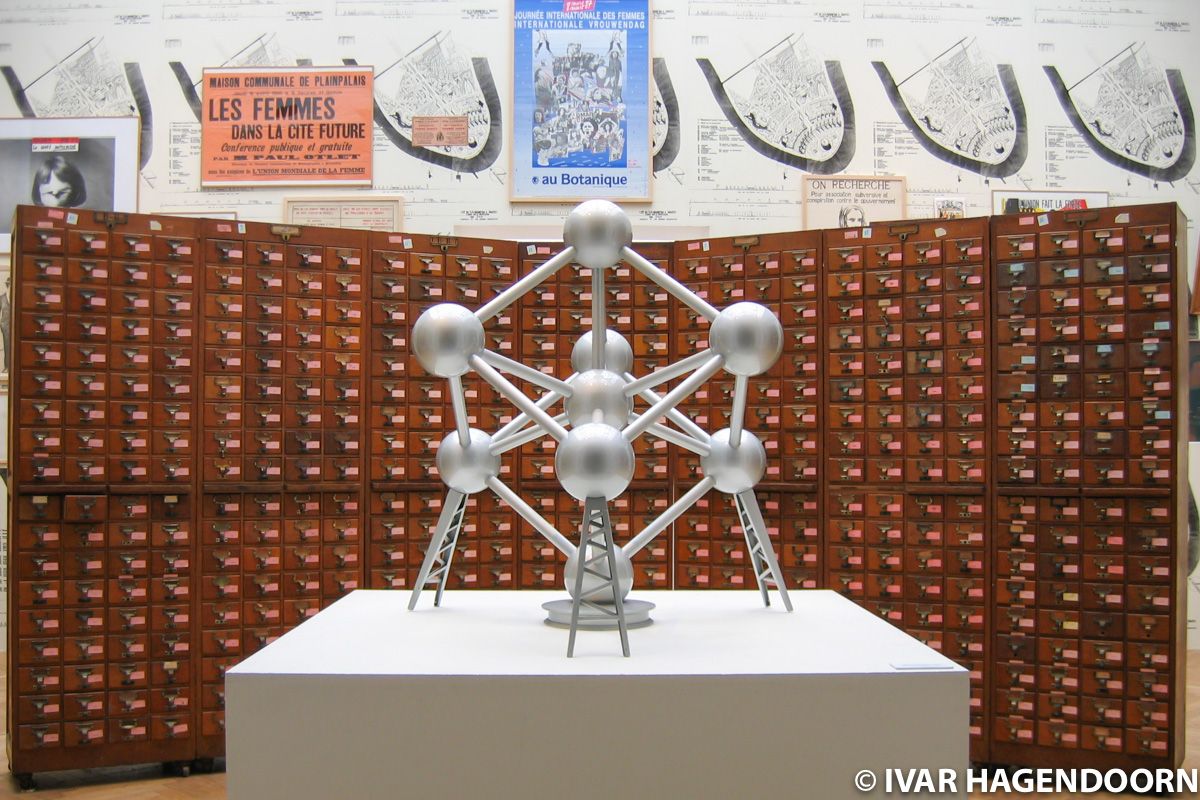
"Visionary Belgium", the exhibition that marks the 175th anniversary of Belgium, opens with a fairground attraction, "Carrousel" (1999) by Carsten Höller. Belgium, that is carnival. A country where the king steps down for one day to allow a law to pass, which he refused to sign. A country where the most sought after criminal, Marc Dutroux, escapes from a law court after his handcuffs had been removed so he could read the papers regarding his impending trial.
Caught between France and The Netherlands, divided into a Dutch and a French speaking part and forever looking for its identity, Belgium is permeated by a sense of inferiority, resignation and sorrow. Adding insult to injury its one addition to world cuisine goes by the name of French fries in the English speaking part of the world. Is it a surprise then that much Belgian art hinges towards the utopian, the absurd and the grotesque? Perhaps Belgium itself is a work of art, as it says on a poster by the artist Johan van Geluwe “Belgium ART ificial since 1830”.
"Visionary Belgium" was curated by Harald Szeemann, the godfather of today’s mix and match art exhibitions. The opening was postponed by two weeks because of his illness, but sadly Szeemann died the day the exhibition should have opened. "Visionary Belgium" is therefore a last chance to see Szeemann’s incredible visual intelligence at work, his passion for all forms of human creativity and his ability to create a patchwork of associations.
One room is dedicated to the late 19th century erotic drawings of Félicien Rops, which mock the social and religious establishment of his time. Attached to a wall in the next room is a work by Sébastien Delire, "Punishment" (2004), a piece of ruled notepaper filled from top to bottom with the line “je n’irai pas bien loin avec une telle attitude” (“I won’t get far with such an attitude”) in alternating blue and red characters. Its placement is subtle. In the room to the right some of Jan Fabre’s sperm drawings are attached to a wall and hanging on a rope from the ceiling is his "Portrait of a sorcerer" (1979-2003), made out of inverted, shiny copper or perhaps gilded drawingpins and nails. But where did Szeemann find the work by Sébastien Delire?
Harald Szeemann’s influence as a curator can also be seen in some installations in the exhibition, which could equally well have been the work of Szeemann himself. Indeed, when I saw the collection of curiosities by Johan van Geluwe I had to go back to the entrance to the room to check whether this was one installation or just another room by Szeemann. The amazing installation “The Belgian colonisation in Black Africa” (2000-2005) by Georges Adéagbo also looked like a continuation of Szeemann’s exhibition concept, merging perfectly with the previous rooms. Adéagbo shows newspaper cuttings, pages from magazines, plastic bags, African masks, empty cans and bottles, dvd and lp covers, even more pages from magazines and newspaper cuttings, a dirty tea towel, some bones, t-shirts, photos and yet more newspaper cuttings, all of them attached to the walls, leaning against the skirtings and neatly arranged on the floor.
The subtitle of the exhibition is “c’est arrivé près de chez nous”, which loosely translates as “it happened in our neighbourhood” and many visitors, especially the many Belgians who don’t think much of their own country, will be surprised by the richness Harald Szeemann has uncovered, despite the fact that many key works were unavailable for loan. All the big names in Belgian art are there: René Magritte, Marcel Broodthaers, James Ensor, Luc Tuymans, Paul Delvaux, Panaramenko, Jan Fabre, Berlinde de Bruyckere, Hergé, but there’s more, a lot more. Szeemann mixes paintings and posters, conceptual films and television footage of two of Belgium’s greatest heroes, Eddie Merckx and Jackie Ickx, with pages from comic books, photos and sculptures of historical Belgian figures, the manuscript for one of the most famous novels to come out of Belgium, “The Sorrow of Belgium” by Hugo Claus and works by obscure artists, which suddenly take on meaning within the larger context of the exhibition.
The exhibition does not try to tell a story. It shows multiple converging and opposing lines, traditions and anti-traditions, as Szeemann wrote in an introduction to the exhibition. Belgium is surrealism and symbolism, but also Catholicism. Tainted by its colonial past in Congo and by the First World War. But Belgium is also one of the cradles of industrialization and some works in the show refer to this part of Belgian history including a toy train wagon. One room is devoted to pigs in Belgian art, of which there are many, from “The woman with the pig” (1886) by Félicien Rops, which shows a blindfolded woman, wearing only long gloves and stockings, being lead by a pig on a leash, to the tatooed pigs (1998) by Wim Delvoye.
The last work in the exhibition is a sculpture by Johan Muyle. It is called “Wat een wonderlijke wereld” (1992), which means so much as “What a weird and wonderful world”. It shows a man with a backpack in which a miniature globe turns around. It is not too difficult to see why it appealed to Harald Szeemann, the nomadic curator who travelled the world, but at the same time carried his own imaginary world with him.
La Belgique Visionnaire/Visionary Belgium is at the Palais des Beaux-Arts, Brussels until May 15, 2005.